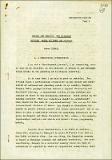Models and policy: the dialogue between model builder and planner

View
Download
Published
182Author(s)/Corporate Author (s)
Kornai, János.;United Nations. Economic Commission for Africa. African Institute for Economic Development and Planning(IDEP);
Metadata
Show full item recordAbstract
The first mathematical planning models appeared in Hungary in 1957-58. Economy-wide and sector planning, both for the medium and long term, had already been going on in Hungary for about a decade but exclusively relying on traditional, non-mathematical methods. The scale of planning could be described by two values: The number of people working in the machinery of planning. Hungary is a small country of ten million people, before the appearance of mathematical planning, the central planning office had a payroll of 500 to 800. In addition, every ministry, the directorate of every industrial brunch, every producing company, and every local administrative authority had a planning office. Altogether, tens of thousands of people were busy planning; Secondly, the number of parameters used in the documentation of the five-year plan. There is no accurate count, but a crude estimate of the order of magnitude would be several Million.
Citation
“Kornai, János.; United Nations. Economic Commission for Africa. African Institute for Economic Development and Planning(IDEP) (182). Models and policy: the dialogue between model builder and planner. Dakar. © UN. IDEP. https://hdl.handle.net/10855/42527”Collections
- Economic Development [8070]
